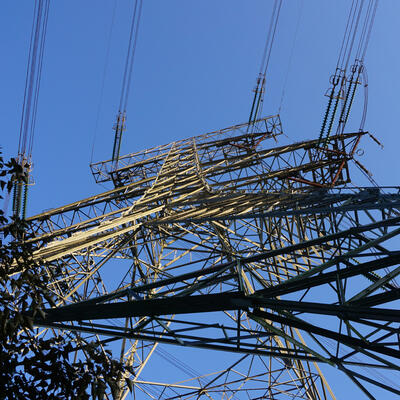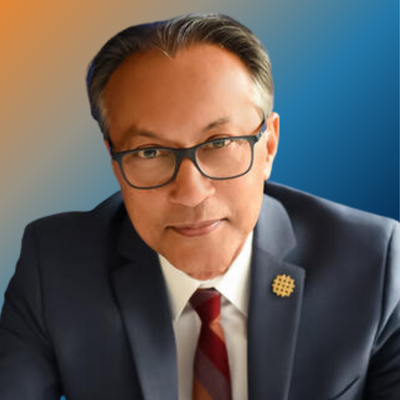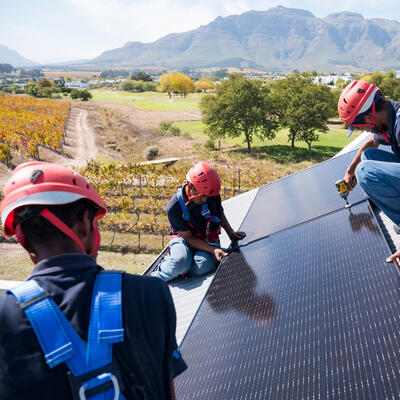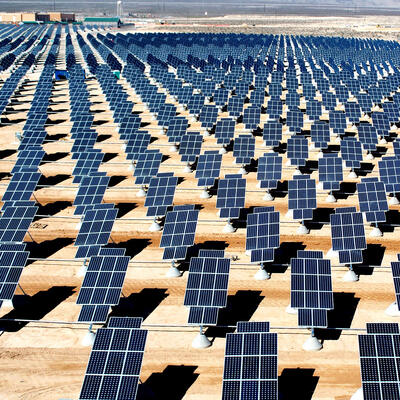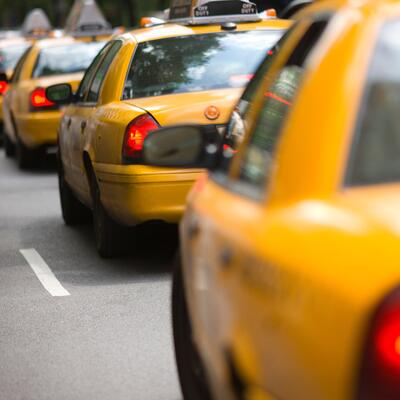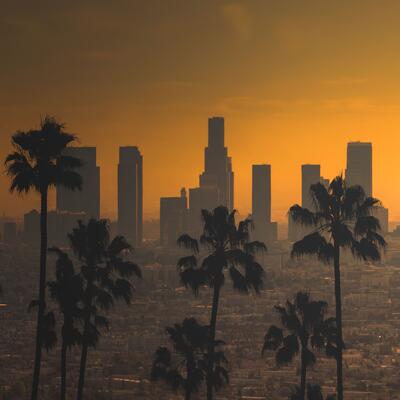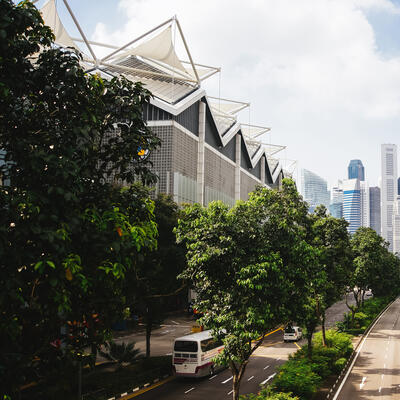
Zero-Emission Cities
Guests
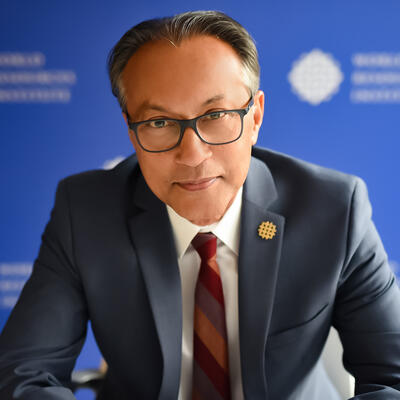
Ani Dasgupta

Eva Gladek
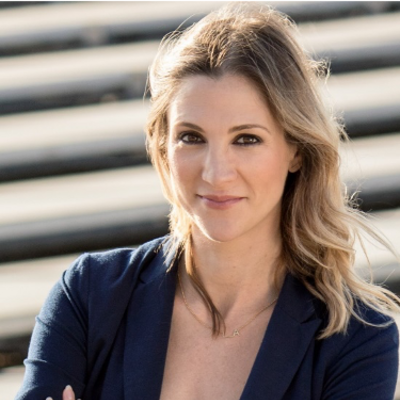
Lauren Faber O'Connor
Summary
Can we solve the climate crisis by reimagining our cities?
Climate activists have long envisioned the zero-carbon cities of the future. Now, with COVID-19 shutting down congested urban areas, city dwellers from Los Angeles to New Delhi are getting a rare taste of clean air and blue skies. But the view is also more clear of things more painful to see - social inequalities that have existed for generations.
“This particular crisis is showing us that how vulnerable our poor communities are,” says Ani Dasgupta of the World Resources Institute. “And whatever we do in the future, the building resilience, economic and social resilience, should be core strategy for anyone of us who are trying to rebuild cities from then on.”
Eva Gladek, founder of the consulting firm Metabolic, agrees. “This is an opportunity to think about what kind of systems do we actually want, what kind of future do we envision for our cities and for our economy,” she says. “And how do we actually try to address multiple challenges at once when looking toward that future.”
Climate One convened experts in sustainability and urban planning from three far-flung cities – Los Angeles, Washington D.C. and Amsterdam – to explore the role of cities around the world in building a just and sustainable future for all their citizens.
And as Dasgupta points out, clear skies are only part of the picture.
“What we’re looking for is not just a low carbon city or low carbon world,” he notes. “We’re looking for a successful city.
“A successful city has a place where people have jobs, people can create welfare for the families and do what they need to do. It is a thriving place that has high quality of life.”
Additional Interview:
Lubna Ahmed, Director of Environmental Health, WE ACT for Environmental Justice
This program is generously underwritten by ClimateWorks Foundation and was recorded online on April 20, 2020.
Related Links:
World Resources Institute
C40 Cities
Metabolic
The pandemic could be a call to action on climate change (Washington Post)
New research links air pollution to higher coronavirus death rates (NY Times)
Full Transcript
Greg Dalton: This is Climate One. I’m Greg Dalton.
Greg Dalton: Climate activists have long envisioned the zero-carbon cities of the future. Now, with COVID-19 shutting down congested urban areas, city dwellers from Los Angeles to New Delhi are getting a rare taste of clean air and blue skies. But the view is also more clear of things more painful to see - social inequalities that have existed for generations.
Ani Dasgupta: This particular crisis is showing us that how vulnerable our poor communities are. And whatever we do in the future the building resilience, economic and social resilience, should be core strategy for anyone of us who are trying to rebuild cities from then on.
Eva Gladek: This is an opportunity to think about what kind of systems do we actually want, what kind of future do we envision for our cities and for our economy. And how do we actually try to address multiple challenges at once when looking toward that future.
Greg Dalton: The path toward zero-carbon cities. Up next on Climate One.
---
Greg Dalton: This is Climate One. Are zero-emission cities in our future? Climate One conversations feature oil companies and environmentalists, Republicans and Democrats, the exciting and the scary aspects of the climate challenge. I’m Greg Dalton.
Lauren Faber O'Connor: If the COVID-19 crisis is showing us anything it is showing us that we are all a completely interconnected society where this pandemic is hurting everybody. And climate change is hurting and will continue to hurt everybody.
Greg Dalton: It’s been said many times -- we’re all in this together. But as the current health crisis so dramatically reveals, not all of our communities have been impacted equally. Today, we explore the role of cities around the world in building a just and sustainable future for all their citizens. And clear skies are only part of the picture
Ani Dasgupta: What we’re looking for is not just a low carbon city or low carbon world. We’re looking for a successful city. A successful city has a place where people have jobs, people can create welfare for the families and do what they need to do. It is a thriving place that has high quality of life.
Greg Dalton: My guests today are three experts leading the charge toward creating that thriving city of the future. Ani Dasgupta is Global Director of the Ross Center for Sustainable Cities at the World Resources Institute. Lauren Faber O’Connor is Chief Sustainability Officer for the City of Los Angeles under Mayor Eric Garcetti. And Eva Gladek is founder and CEO of Metabolic, a consulting firm based in Amsterdam that is working towards a sustainable economy.
All three are joining me remotely today to talk about building and maintaining zero-carbon cities. This program is generously underwritten by the ClimateWorks Foundation, which has supported Climate One since I created it more than a decade ago.
The most recent report by the IPCC, the Intergovernmental Panel on Climate Change, says that to reach our climate goals, every city in the world must be at zero carbon emissions by 2050. Where do we stand right now? Ani Dasgupta gives us the global view.
PROGRAM PART 1
Ani Dasgupta: As you know, there’s no city today in the world that is carbon neutral or zero carbon. There will be some hopefully soon and those will be in countries where the energy supply is more green than others, so people talk about Copenhagen for example. We did the study last year looking at is it possible to get to zero carbon in 2050? And our conclusion from that work is it is possible even with the given technologies that is there today. And that initiative has to be focused on the big sectors in cities that are the big carbon emitters. For example buildings, which is the biggest one, transportation, waste, materials that’s used. But what also came across clearly, Greg, is not only these things needs to be zero carbon but the energy used in the cities needs to be green which is a critical factor that cities often don’t control. So cities need to work with their regions to get to a zero carbon outcome. But the signs at least and our work shows that it is absolutely possible. But at the same time we actually have to kind of use, live and manage cities differently to get there.
Greg Dalton: Eva Gladek, how do you look at cities holistically trying to get to zero emissions?
Eva Gladek: Well, I think Ani already covered a lot of the kind of points that you would take into account in a holistic perspective. But one of the things that we always emphasize is this whole systems approach. And the fact is that something that’s often overlooked in looking at moving to zero emissions for cities is consumption based impacts. So basically all the materials that cities are consuming, all the food that people are eating, all the materials that are coming into produce all the buildings. These actually have embodied carbon emissions that are very significant. And we recently finished a study for the city of Boulder, Colorado where we actually calculated how much of these emissions, how much of the total emissions that you can attribute to Boulder are in this kind of consumed material and it's over 50%. So it’s very significant.
So if you actually want to move to being a zero emissions city you have to go with indeed your own buildings, how you design your infrastructure, your urban areas. All of those kinds of things that have to do with what’s going on in the city itself but also what you’re consuming the energy and the materials.
When it comes to really looking at it from this holistic perspective, you always have to look at the drivers of consumption. So it's very easy to think okay to decarbonize the mobility system let’s just put in a bunch of electric cars. But that can actually create knock-on effects where we’re demanding much more energy and resource intensive materials that we can’t recycle very readily yet. When actually we need to look at how do we design our urban fabric in such a way that we don't need to drive that we actually that it's very easy to walk because neighborhoods are porous because we have almost everything that we need in our close proximity. So these are kinds of systemic ways of thinking about cities and moving to zero carbon.
Greg Dalton: Lauren Faber O'Connor, people think of Los Angeles obviously they think of cars. Is that fair that cities often undercount the materials and impact kind of the consumption part because what I hear about cities is a lot about buildings, cars than maybe food waste.
Lauren Faber O'Connor: We’re learning a lot about consumption based emissions actually. And I commend all of you, if you are interested in consumption based emissions. C40, which you mentioned, the mayor is now chair of which is a coalition and network of 96 megacities of the world. And they are really raising the bar together we are raising the bar what it means to uphold the Paris climate agreement and how we lead on climate action. But one of the things that because we’re learning a lot more about embodied carbon and consumption based emission. C40 actually recently put out a report last year on consumption based emission looking at some of the huge drivers of emissions based on individual behavior. And essentially it looks at all 96 cities and shows that if we can address our consumption emission that’s about 10% of global emissions right there. It’s supposed to be an empowering idea though because we always are looking for opportunities to as individuals be part of the solution.
And so when you look at your food consumption when you look at your air travel when you look at the way you get around the city or elsewhere. Those are real things you have in your power to make a difference. But just in terms of, you know, looking at things piecemeal as a city. In L.A. we have to look at things as more of a holistic interconnected woven fabric across our emissions because a city like Los Angeles we own and operate our own municipal utility. We own and operate the port of Los Angeles together with Long Beach as the largest port complex of the nation and beyond. And we own and operate our own airport, LAX, the busiest airport. And so we have to look at as we're moving toward more renewable energy as we’re electrifying our transport. We then take on more of that responsibility through our municipal utility as we’re moving toward electrifying our buildings. We’re taking on that responsibility again through our utility, making sure that we are increasing our efficiencies but then we’re not overburdening the grid. But really have the power in our own hands as a city we’re structured in L.A. to have huge, huge impact.
Greg Dalton: Eva Gladek, you know, we talk about lowering consumption. Certainly that’s happening now as people are not shopping, etc. But isn’t our economy tied to us consumption we’re trapped in this system that’s driven by consumption. And we're hearing well we need to consume less, but it isn’t that sort of prescription for tanking the economy?
Eva Gladek: Well, there’s a number of things to unpack here. So, consumption based emissions don't necessarily have to do with personal consumption when you're looking at the city context. It has to do with all the kind of materials that’s coming in to support the infrastructure, etc. So that's actually a much larger piece. And a lot of that, so you can get the same amount of service and value out of the economy with many fewer materials if you manage to actually decouple materials from service delivery. So there's through smart design through moving to a circular economy. We can actually provide the same amount of consumption in terms of value or goods or experiences delivered with many fewer resources. So it's really that kind of that critical idea around how do we actually manage to do this decoupling. And I mean of course you get into a lot more philosophical questions too. How much do we really need to consume? What is the point of consuming all of the stuff? We want to consume to the level where we’re satisfied we have the experiences that we want where we’re not wanting for anything. But there's a level at which it just becomes empty beyond that as well.
Greg Dalton: Right. And we’ve got right now a lot of low income people that aren’t perhaps consuming enough they don't have the level of comfort or security that we would be expecting that they would like to have.
A recent study from Harvard analyzed air quality and COVID related deaths in every county in the United States. They found that even a small increase in long-term exposure to fine pollutants or particulate matter is associated with a 15% increase in the COVID-19 death rate. Other words, the more polluted your area is, the more likely you are to die from COVID-19 which attacks the lungs. Those study results were no surprise to Lubna Ahmed, director of Environmental Health at WE ACT for Environmental Justice, a community organizing group in New York City.
ROLL-IN:
Lubna Ahmed, Director of Environmental Health, WE ACT for Environmental Justice
Greg Dalton: That wasLubna Ahmed, director of Environmental Health at WE ACT for Environmental Justice in New York City. Ani Dasgupta, I’d like to hear from you responding to that from Lubna talking about this kind of connection between -- the earth is healing itself and perhaps that’s a longer term thing but there’s also this inequity and inclusion piece that she mentioned.
Ani Dasgupta: Two things are striking to me about what’s happening around the world. The fallout every country have poor people are much more affected. Not only from the medical part of the crisis but the ensuing economic prices that still in play in some country and will happen for months everywhere. Everywhere you see if you look at, you know, New York, if you look at India what's just happened in a lockdown. It’s just striking how vulnerabilities are showing up. Lot of people lot of us included in this call been talking about that we've been building economies and societies that are kind of geared towards growth and not towards long-term resilience, suddenly we see it. One crisis takes place and everything one after how is social crisis and medical crisis so quickly becomes economic crisis and so quickly becomes a physical crisis of public transport system not working.
I think that point of how vulnerable our poor society is and how much we have to work towards resilience is so critical. We argued and always argue that what we’re looking for is not just a climate low carbon city or low carbon world. We’re looking for a successful city. A successful city has a place where people have jobs, people can create welfare for the families and do what they need to do. It is a thriving place that has high quality of life. We just discussed about whether we need, you know, how much should we consume and we have argued that we should talk about what are the quality of life we want rather than what we need to consume.
And finally, can you do these two things while actually not producing that much carbon, reducing carbon footprint. That is a strategy for forming a successful city. Lauren talks about L.A.’s strategy is very much good towards these three outcomes. The question is, I think for all of us these clear skies that the Harvard study you talked about, actually provide us a kind of a shocking but good experiment. That what will happen if there were no cars spewing carbon or factories that citizens across the world are able to witness. What would it be like to live in cities that are safer, quieter, cleaner and we can breathe air. And I hope that this particular outcome though we didn't plan it, actually can help us use a political momentum towards these changes because we know that these changes are possible to get there. But just like COVID we all need to work together and it’s not just government policies. So this is behavior, our choices of how we use, our choices of not using cars and using public transport. These together gets to an outcome that we are seeing.
But I just want to finish by I can’t stress enough how much this particular crisis showing us that how vulnerable our poor communities are. And whatever we do in the future the building resilience, economic and social resilience should be core strategy for anyone of us who are trying to rebuild cities from then on.
---
Greg Dalton: You’re listening to a Climate One conversation about designing successful cities for everyone. Coming up, improving our cities by changing our diet.
Ani Dasgupta:One of the biggest things cities could do actually for carbon per city is all of us could do, is to eat less beef. That single thing could actually dramatically shift how much acreage is needed to grow soybean and other crops to feed animal stock.
Greg Dalton: That’s up next, when Climate One continues.
---
Greg Dalton: This is Climate One. I’m Greg Dalton, and we’re talking about creating carbon-free, sustainable, equitable cities. I’m coming to you from my home in the Bay Area, and my three guests are beaming in from their homes. Lauren Faber O’Connor is head of sustainability for the City of Los Angeles, Ani Dasgupta is with the World Resources Institute in Washington, D.C.
Eva Gladek joins us from Amsterdam, where she leads the consulting firm Metabolic. I asked her how the social safety net in the Netherlands is responding to the current health crisis compared to here in the States
PROGRAM PART 2
Eva Gladek: My general impression is that it’s much better here. So I'm originally from the United States my parents are right outside of New York City right now. And I’ve been hearing from them and from a lot of my friends back home what kind of dire situations people are facing. Not being able to get through on the phone to the unemployment office. Having just complete lack of security about rent and all sorts of expenses. I started my company here in the Netherlands almost 8 years ago. And right when the crisis here started the government immediately said that if any small business owner was not able to pay salaries 90% of those salaries will be covered indefinitely throughout the crisis. There's been a freeze on evictions like no one can be evicted for not being able to pay rent. All sorts of systems have been put in place. There's a lot of security. And immediately we were also told that we can defer all of our taxes throughout this entire period to basically assist in any kind of issues. And these aren’t even loans these are basically grants and, you know, interest-free kind of tax deferrals, etc.
I can't speak for the entire of Europe I know that the situation in the Southern European countries is far more dire and of course there’s a lot of conflict between the European nations about how to resolve some of these issues. There's obviously wealth disparities here. But all of this points to this question of resilience. And one of the things that I really think this whole crisis has laid bare are the cracks in the system that we’ve built. The inadequacies of certain things and also the fact that inequality ultimately is a risk to everyone because as you have this extreme disparity in distribution of wealth you create huge swaths of the population that are extremely close to the poverty line and are basically not able to survive any kind of significant period during a crisis. And that starts to break down or risk breaking down the entire functioning of the economic system even for those who are wealthy and hiding out somewhere. So and that's just one of the many things that this has revealed that has been a tragic but also very illuminating experiment.
Greg Dalton: Lauren Faber O'Connor. Governor Eric Garcetti of Los Angeles gave his state of the city address. It was quite dark. He said the city is under attack. The fiscal situation is the worst it's ever been. How is that gonna affect Los Angeles' ability to get to net zero and to invest in green infrastructure. He announced an ambitious Green New Deal earlier this year. How much of that is risk now given the current fiscal environment?
Lauren Faber O'Connor: Well, the current fiscal environment is risking everything. It’s even risking our jobs, you know, the large proportion of the city family including myself will be taking a furlough, 26 furloughed days in the coming fiscal year. But those are things we have to do and we still count ourselves lucky to have jobs where we see such extreme, you know, inequity not just pre-existing but now being created and divided even further. And it’s interesting to hear what Eva was saying what’s been going on in the Netherlands because a lot of those things that I guess in Europe are seeing as ways to keep people from, you know, being on the brink are things that the mayor instituted immediately upon the crisis. Instituted immediately an eviction prohibition for both residential and commercial as well as the furlough of taxes the furlough of rent and housing rent control apartments and homes. And has been calling on the federal government for a rent-freeze as well which is not in our authority to be able to do, I know you heard him say that yesterday in the state of the city as well. All of these things he recognizes are really ways to protect people and in the future when we build back we don’t wanna necessarily build back to the normal that existed predating the pandemic which was sustaining these types of and growing these types of inequities. But really building back to a new normal that celebrates our diversity and brings us together and lifts people up. Whether that’s through access to housing whether that’s through access to college. All of these things that really will make the difference between who is disproportionally impacted by dirty air or unclean water, again, which makes this susceptible to these types of pandemic.
To see the improvement in our air-quality well beyond anything that I’ve seen in my lifetime some of the cleanest air in the world in Los Angeles right now is an inspiring look at what can be and how quickly the earth can heal itself. It really is exciting but not at the cost of a pandemic, not at the cost of people’s health, not at the cost of people’s livelihoods. The message to take away cannot be that the only way to reach this kind of regenerative planet is through stopping all activity across the world that’s not the take home.
Greg Dalton: Ani Dasgupta, one thing that's being, some things that are being rethunk, reconsidered globalization is being reconsidered right now, this kind of far-flung fragile supply chains. So from where you sit how do you see globalization being reconsidered as countries talk about kind of bringing production, bringing things closer home, there’s sort of our country first mentality that could rise out of this.
Ani Dasgupta: I think two opposing thoughts are racing through all of our minds during this period. One is, I think all of us predict that we will see lot of discussion of making supply chains much more resilient, closer to the source those where it’s consumed so that we are not dependent on these disruptions or not affected by the disruption of supply chains. Which in a kind of a scientific way or in a kind of person like me who’s interested in low carbon is a good thing. Actually this will reduce carbon footprint of moving things around it might lead to good thing. But we also fear and I feel very much that this is the good thing part will be also married with an idea of exclusion and closing down boundaries and lack of globalization or global partnerships which will not be good.
As we can see right now from what's happening with the pandemic was to solve this kind of problem and this is not the last global crisis we will have. We already know that what is happening already now will happen from the climate crisis. It is across the world actually communities across the world are facing climate related outcome already. There are more heat related death in India last year than any before.
So these are things are happening we just don’t read about it. And so I think these opposing forces, Greg, I don't know how will it pan out. Something good might come out of building more resilient, more connected, much more circular economy as Eva was talking about that has materials have less carbon footprint as they were consumed. But I think closing down borders and being nationalistic, I don't think that with the work I do is gonna be good. The best thing we do in our organization we actually learn work very close with C40 is actually how cities learn from each other across the world. That’s the fastest way people learn. So I wish I could tell you exactly how this will pan out but this two thoughts are actually going through I think everyone’s mind including there are work a lot about how will global cooperation increase because of this or decrease because of this. And we’re hoping it’s the former.
Greg Dalton: Eva Gladek, your thoughts on that. And you think that we got to be careful about not designing future of cities for one moment or one crisis; as bad as COVID is, we have to think beyond COVID and not kind of overreact to this current crisis and kind of design cities with this pandemic in mind.
Eva Gladek: Yeah, absolutely. I mean, I think, there's a tendency now to in our previous discussion, Greg, we talked about how people might be scared now to get on public transit because there is now this kind of risk of exposure to this pathogen. And that we have been making a lot of progress on moving towards reusable cups and materials in the kind of retail sector. And now that's also potentially going to be less interesting. I do think that these are not -- designing the system to respond to these particular concerns is not the right thing to do. This is an opportunity to think about what kind of systems do we actually want, what kind of future do we envision for our cities and for our economy. And how do we actually try to address multiple challenges at once when looking toward that future. And then actually use this crisis as an opportunity to put money in resources into that direction to invest in infrastructure that is let’s say future proof to the extent that that’s possible against multiple different types of problems. So instead of thinking okay well we need to revive this existing public transit system that has all sorts of issues with it. What kind of public transit system can we envision in the future that addresses both health and mobility concerns and decarbonization and also some other things at the same time. And also looking at what does that mean for urban design.
Related to the kind of globalization versus kind of closing out of borders. I also think that there are multiple ways to look at that question. We know for a fact that we have kind of inadequately dealt with the resilience of our global supply chains because they are too concentrated. They're not designed for the kind of optimal transport of resources. But there’s lots of ways to deal with that that don't involve necessarily shutting down borders. We can also create local resilience resource flows and economies paired with a certain longer further distance more global chains, etc. So I really think it all has to do with us using this as an opportunity to envision the kind of future that we want to create and then putting resources toward building that future and using it as a kind of leapfrog moment to also address some of these crisis issues.
Greg Dalton: Lauren Faber O'Connor, what are some things now that are possible now that were kind of unimaginable before. We’re in this moment where things, you know, cities are shutting down streets because there’s not much car traffic and kind of pedestrians are taking over streets. What are some things possible now that we're not really imaginable pre-crisis?
Lauren Faber O'Connor: Well, there’s a number of things that we’re learning and that we’re taking on that may not have been possible before certainly not in such a swift time frame. And a lot of that comes from what Ani was talking about is the collaboration and learning from other cities. It’s been incredible to see the kind of engagement that our C40 cities and our cities around the country around the state around the country have been having on a regular basis. Our mayors talking to each other to talk about lessons learned, to ask each other questions on how we dealt with one thing or another. And to share some of the things that we’ve been doing to improve people’s lives, to improve or alleviate the situation. I remember hearing just last week about one city talking about helping and rebating the sale of electric bikes. We’re looking at -- the mayor announced just a week ago a new program called adapt. Which is moving our street sweeping and our paving from residential areas to higher traffic corridors now that it’s been really difficult to close down, really difficult to do any work in a public right of way. But now we’re able to accelerate that action which really will help people as well.
First thing that in accelerating timeline for public transit, we’re looking at bus lanes and bike lanes that have been hard to take the time to put in as well. These are major opportunities. Teleworking itself is also something that has not been widely adapted in a lot of industries, certainly not in a public sector. And now we’re seeing so much more opportunity where people would maybe not employed in a public sector but in private sector fly to a meeting, huge carbon footprint there. And now they’re seeing that that client relationship can still thrive without that kind of face to face if it’s not completely necessary. So we’re seeing a lot of things even around permitting streamlining to get businesses up and running quicker. To what can we do to increase our housing construction this is only showing how much we continue to direly need more housing. But in terms of the supply chain in the local versus global; I agree with what Eva was saying. There is a role for the global supply chain which gonna have significant carbon impact for the good or for the worse. But if we can impact that just think about the scale that we can affect. And at the same time looking at our local infrastructure it’s huge opportunities for job growth for career growth. Whether that’s in the recycling sector where we need to develop local markets for circular economies as Eva was saying. Our local water infrastructures so that we’re not dependent outside of the city for resilient treatments as well. All of these things are really helping bring more equity into our system as well as a stronger economy.
---
Greg Dalton: You're listening to a conversation about transforming our cities. This is Climate One. Coming up, we’re all in this together – or are we?
Eva Gladek: We can either choose to join hands and do this together, to double down on the climate crisis and all the other environmental crises that are facing us, or to close off, isolate ourselves you know, point fingers and blame others..
Greg Dalton: That’s up next, when Climate One continues.
---
Greg Dalton: This is Climate One. We’re talking about the pathway to better cities. I’m Greg Dalton. My guests are three experts in urban planning and sustainability: Eva Gladek of Metabolic, Lauren Faber O’Connor of the City of Los Angeles, and Ani Dasgupta of the World Resources Institute.
One key ingredient for a successful city that doesn’t often get talked about is food. Not all communities have access to affordable, healthy nourishment. Recent school closures and unemployment due to Covid-19 have only worsened the problem. How do we rebuild our food systems to make them more equitable, more sustainable and more resilient
PROGRAM PART 3
Eva Gladek: The food system is the single largest source of impact that humans have on the planet. That's one of the things that we know that it has to transform very radically if we actually wanna move to a decarbonized sustainable economy. And cities have a huge role to play in that. For one thing we know that the food system currently occupies 38% of the surface of the planet and if you include if you take into account the parts of the earth that can support plant life then it's 50%. And we know that based on the FAO’s projections food output is estimated to double by 2050. Now that if you just do the math is impossible. So if we are already using half of the earth for food production and that food output needs to double under the current efficiencies that would basically mean no nature left that all of our land will be used for food production.
Another thing that's going on in the food system is that we’re moving around huge amounts of resources, nutrients in particular. So we’re extracting phosphorus and nitrogen from soils and we’re moving that into the cities. So cities are like these resource trains in a way that are sucking all these nutrients from their hinterland. And then processing them into waste, either food waste or human waste. And then a lot of that just get flushed out into the environment and causes eutrophication or other issues we’re not recapturing when it’s actually a really valuable resource.
So if you start to think of more circular cities and what they need to look like in the future, first of all they need to stop being this kind of major just one-way sinkholes of consumption. They actually have to start producing. And when it comes to the food system that means capturing those really valuable resources by reengineering wastewater treatment systems to actually beneficially recover those resources and turn that into food production. Maybe not in the city itself, but at least in the peri urban regions so that we have these production systems that are really closer for the most part to the centers of population and the centers of these nutrients. Then you have these close much smaller cycles of nutrients they’re not sucking resources from the hinterland anymore and you’re creating local economies that are also then providing new kinds of employment and allowing people to thrive in that context. There are multiple benefits that you get from starting to close those cycles on the urban scale
Greg Dalton: And is Charlotte, North Carolina example, it's kind of U.S. city that's taken some steps in that direction?
Eva Gladek: So Charlotte has committed to becoming a circular city. We actually developed a strategy together with the city a couple of years ago and they’re now working toward that in multiple different ways. So a large part of that focuses on inclusive economic growth and development and trying to actually tap into the circular economy as a strategy for reducing inequalities in the city context. So Charlotte in a kind of ranking of the 50 largest cities in the U.S. has the lowest social mobility in the U.S. So if you're born into poverty there you have less than a 5% chance of getting out of poverty in your lifetime which is a pretty abysmal figure. So the idea that the mayor's office had with Charlotte was that if they can use the circular economy as actually a strategy to rebuild the local value chain and actually create new kind of forms of employment, this whole what Lauren was talking about, using the green economy as a lever to actually move toward solving multiple problems at once by creating new forms of employment.
Greg Dalton: Ani Dasgupta, circular cities is that happening anywhere? It sounds like something that might be good for Boulder, Charlotte but is that gonna happen at other cities maybe that aren’t as wealthy or aren’t U.S. based?
Ani Dasgupta: I think cities across the world are thinking about that in different ways. It's very much as Eva is saying this idea from how do you actually decrease their carbon footprint is not just in the big infrastructure sector but also in consumption. I agree with all the things that are pointed out. The thing that I want to point out is there are many things cities can do that is beyond urban agriculture. It’s how they work with their city regions and how they create a regional economy that is good for the region and also good for the city. Not only food that Eva talked about but how water is managed, how air is managed. These things cannot be done in jurisdictional boundaries. And there are many examples of that nature and we're working, so that water is one example.
There are 200 cities across the world that will be without water ration. And how actually to solve that, you can’t just solve it inside the boundaries of cities. You have to work with the city region for them to work together to a more sustainable, reusable water. Like bringing water supply and water resources together. L.A. is very familiar with this part of the story because they had to figure it out. So things like that are happening. What is also very much happening as what Eva talked about I think there is lot of cities things where your cities can do on recycle and reuse of water. Not only from the waste that Eva talked about but how water is conserved in buildings, rainwater harvesting. There are things that you can build infrastructure differently to aid towards a much more circular economy circular resources around. Creating new jobs also creating new ways of building things.
The food story is a very interesting story. One of the biggest things cities could do actually for carbon per city is all of us could do, is to eat less beef. That single thing could actually dramatically shift how much acreage is needed to grow soybean and other crops to feed animal stock. So, you know, I want to underline it’s not just infrastructure and policy, it’s also behavior and individual choice that we need to make to get this thing going. And that is why this particular moment for me, Greg, and I completely agree with Eva, we should not be caught with COVID and we should think long-term, all of us should. But it actually has shown us that it is possible to make big changes. It is possible to get societies to actually act very differently for collective good. And that is inspiring in some ways that it is possible to get people together and people will stay at home because it's good for not only them but for everyone else. These are the kind of things, lessons I hope we learn because to do anything Eva is saying we would need like a whole society effort.
Greg Dalton: If you’re just joining us we're talking about zero emission cities at Climate One. I'm Greg Dalton. My guests are Ani Dasgupta, Global Director the Center for Sustainable Cities at the World Resources Institute. And Lauren Faber O'Connor, Chief Sustainability for the City of Los Angeles. And Eva Gladek, Founder and CEO of Metabolic, a consulting firm based in Amsterdam.
We’re gonna go to our lightning round. First asking Lauren Faber O'Connor. What is the urban transit system anywhere in the world that you admire most
Lauren Faber O'Connor: The first one that pops into our mind that we work with a lot is the city of London. They have really taking the issue of air pollution, made it something that people really understand through a robust air quality monitoring network. And enabled the city to then make some big sweeping changes to whether that means congestion pricing and creating a low emission zone, electrifying their taxicabs. Really going super quick in how they’re electrifying their buses as well. They’re serving as a great example around the world.
Greg Dalton: Thank you. Eva Gladek, what’s your favorite city to bike in?
Eva Gladek: I would have to say Amsterdam because I live here. I don't even have a car so I live on my bike and it’s amazing.
Greg Dalton: Ani Dasgupta. What’s a city with great urban planning for the next 20 years?
Ani Dasgupta: Well, there are many cities. My most exciting personal choice actually is Seoul, Korea because how much it has changed, which is a very big complicated city. But how much of the change by simply planning. There are many examples like that but Seoul really is one of my favorite place of the change and they showed change is possible.
Greg Dalton: Eva Gladek. A city you find really frustrating to travel around in as an urban thinker and visionary?
Eva Gladek: I mean I guess this is just based on recent experience. Buenos Aires is a bit of a mess. I tried biking with my entire group and I think the buses actually tried to run us off the road.
Greg Dalton: Ani Dasgupta. A city that is doing a really good job advancing water as a civil right?
Ani Dasgupta: As a civil right I think Durban, South Africa is doing the most in figuring out how the poorest part of society can get access to water by making water free for the first 50 liter per capita consumption. I wonder on the line, water scarcity is gonna be one of the major, major things you will hear next as crisis across the world.
Greg Dalton: True or false. Lauren Faber O'Connor, Los Angeles had sufficient ventilators so it sent some to Detroit?
Lauren Faber O'Connor: That is true. Good planning.
Greg Dalton: Last one. Eva Gladek, one opportunity for a circular economy is mining of gold from human poop?
Eva Gladek: Potentially. We do poop out $12 of gold each year. Each person does. So if you figure out how to do that, then you could.
Greg Dalton: Yeah, that was a new one, thank you.
We have a question from Dylan via YouTube. “What opportunities are presented by the collapse of oil prices and minuscule interest rates?” Ani Dasgupta, cheap oil and cheap money.
Ani Dasgupta: I thought the opportunity that's provided by cheap oil and the difficulty oil companies are facing is actually go wholehearted and promote the alternatives that exist on solar, wind. And because all the time we've been told we can't do these things because oil companies are too powerful and too big and too omnipresent for us to change. This might be a moment for the world governments will come together and make the tipping points and find jobs for the people who work in the oil industry and wind and solar industry. Because the economics are doing that is there; the political will I hope can happen.
Greg Dalton: Another question from YouTube. This one for Eva. This is from The Fearless Peanut. “I know this may sound a bit obnoxious and controversial but why is slow economic growth a bad thing? Is it good to stop obsessing over economic growth and focus on equity and environment?”
Eva Gladek: Well, if you ask me slow economic growth is not necessarily a bad thing but we don't have an economic system that's designed to handle it. Our entire system is designed to work on growth. And so you can actually move to a different model of economy: a steady-state economy for example, or economies that have entirely different logic behind them where you can actually handle not having continuous growth. And I do think that these are things that we have to really look at very carefully and see is the economic system that we’ve designed the appropriate one. I’m actually working on a book on this topic to really look at what kind of economy is compatible with a circular sustainable outcome that produces equity and resilience. And I don't think that it’s the current system that we have now.
Greg Dalton: We’ve been talking a lot about reducing carbon emissions getting to zero emission cities. It is very important and necessary at the same time we know that cities need to adapt to change heat rather extreme storms that sort of thing. So Ani Dasgupta, as you look around the world, how are cities that are urbanizing those cities are mostly on the coast and yet we know that the coasts are vulnerable and there's some discussion about managed retreat from certain coastal cities. So how's that gonna happen where you have this massive migration into cities while cities are gonna face stress to perhaps gradually relocate from where they are.
Ani Dasgupta: You’re absolutely right. I mean we are seeing across the world the impacts of climate change already. The flooding for example, urban heat, droughts, lack of water and coastal flooding. The two data points that are important, you know, most people in the world live on the water or near the water simply because that’s how cities grew in the world because of trading routes. And the other statistic that’s very important is about a billion people across the world live in informal, semiformal, what the right word is, in housing that is not structurally or legally sound. Now these two things overlap, right. The poor people get to live in land that is the most vulnerable. So a lot of poor people actually live in flood-prone areas. So one of the things that will happen and has to happen is how we actually focus on this one billion people. One billion people out of 3.5 or 3.6 billion people in the world that live in cities it's a very significant proportion of people who live in semiformal, informal housing.
So our recommendation has been for cities to focus on housing and actually bringing the stock up so they can become, importing housing stock for which it is, but get better service, better flood protected. And some places relocated, relocation always has been very, very tricky because most of the time relocation has not been done in a fair way for the poor people. Like it’s often been associated with people landed part of the society taking land important land over rather than actually protecting the poor.
So relocation by definition doesn't actually have lot of trust in lot of societies we work in. But some of that would have to happen but more can be done by us truly focusing on where poor people live and actually making their housing more sound making it more protected and making better service. The dichotomy we face in the richer countries in the world we’re talking about optimizing use. Meaning using less electricity using less energy. In lots of places we’re working 650 million people in cities actually don't have energy access that is dependable. So some place in the world energy has to increase to get to better quality of life. So this discussion has to be about quality-of-life rather than just consumption. Then again, we’re kind of gonna go to a dichotomous discussion between the rich and the poor. So this is a very important point, Greg. The more important point is this is actually happening now it's not a something in the future. And cities across the world that we’re working in trying to figure out what to do in my own judgment is this is a way we can get more citizen in the world thinking about climate because they're facing it right now.
Greg Dalton: Lauren Faber.
Lauren Faber O'Connor: If the COVID-19 crisis is showing us anything. It is showing us that we are all a completely interconnected society where this pandemic is hurting everybody. And climate change is hurting and will continue to hurt everybody. What we’re seeing in terms of the disproportionate impact in communities in this current pandemic are illustrative of the kind of disproportionate impacts that we’re seeing and will continue to see with regard to climate change. And therefore, the impacts that are felt in some of the places that Ani was just talking about will hurt all of us collectively, whether that's the downstream impact on our economy whether that’s the downstream impact on health cost. Whether that’s the downstream impact on national security as well where we see that destabilize democracy, then are more susceptible to disruptions that leads to our security system and war which of course, when one area is in that kind of conflict it affects us all and our only source of sort of anything not only do we have to work on fortifying people who are already being impacted. But we have to be able to walk and chew gum at the same time. We have to be able to minimize the impact of this crisis by reducing our greenhouse gas emissions at a record pace. We have to be able to take on that ambitious commitment across the world, while also protecting communities that are already hurting.
Greg Dalton: Eva Gladek, your thought on, you know, you think in systems how to build new systems while kind of retreating or managing systems that are under stress. And what we ought to be thinking about as we close out.
Eva Gladek: Yeah. I mean I really love what Lauren just said, and what Ani said before. I think that fundamentally, this crisis has shown how everything is interconnected. And it has shown us that we’re at the kind of inflection point. We can either choose to join hands and do this together to double down on the climate crisis and all the other environmental crises that are facing us and actually move forward into a better future together. Or to close off, isolate ourselves you know, point fingers and blame others. And you know, this is a kind of it’s a historic crossroad that we’re facing as humanity. And I think it's important that we have dialogues like this, to also encourage everyone to take the right path in moving forward.
Greg Dalton: You know, this is a new thing to have a guest in Washington DC, one in Amsterdam, one in Los Angeles. None of us got on an airplane to participate in this. You think you’re gonna fly less in the future, each of you?
Eva Gladek: I hope so.
Ani Dasgupta: I think so, and I hope so too.
Lauren Faber O'Connor: Right.
---
Greg Dalton: On Climate One today we’ve been talking about the zero-carbon emission cities of the future. My guests were Ani Dasgupta, Global Director of the Ross Center for Sustainable Cities at the World Resource Institute’s, Eva Gladek, Founder and CEO of the consulting firm Metabolic, and Lauren Faber O'Connor, Chief Sustainability Officer for the city of Los Angeles
Greg Dalton: Videos of this and other conversations are available at climateone.org. Subscribe to our podcast on Apple Podcasts, Spotify and other major platforms. Please help us get people talking more about climate by giving us a rating or review. It really does help.
Greg Dalton: Kelli Pennington directs our audience engagement. Tyler Reed is our producer. Sara-Katherine Coxon is the strategy and content manager. Steve Fox is director of advancement. Anny Celsi edited the program. Our audio team is Mark Kirchner, Arnav Gupta, and Andrew Stelzer. Dr. Gloria Duffy is CEO of The Commonwealth Club of California, where our program originates. I’m Greg Dalton.
